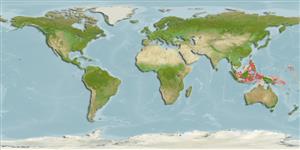>
Gobiiformes (Gobies) >
Gobiidae (Gobies) > Gobiinae
Etymology: Eviota: No etymology given, suggested by Christopher Scharpt: from Latin 'eu' for 'true' and 'iota' for anything very small, in combination 'truly very small' referring to it as being the smallest vertebrate at the time it has benn described by Jenkins (thus, making the suggestion by Scharpt plausible; pictifacies: Name from Latin adjective 'pictus' or painted and the female noun 'facies' for face; referring to the bright red spots on the side of the head, similar to those painted on a clown; treated as a feminine compound adjective.
Environment: milieu / climate zone / Mức độ sâu / distribution range
Sinh thái học
Biển Cùng sống ở rạn san hô; Mức độ sâu 3 - 8 m (Ref. 115282). Tropical
Sự phân bố
Các nước | Các khu vực của FAO | Các hệ sinh thái | Những lần xuất hiện | Bản đồ điểm | Những chỉ dẫn | Faunafri
Western Pacific: Indonesia.
Bộ gần gũi / Khối lượng (Trọng lượng) / Age
Chín muồi sinh dục: Lm ? range ? - ? cm
Max length : 1.6 cm SL con đực/không giới tính; (Ref. 115282); 1.7 cm SL (female)
Short description
Khóa để định loại | Hình thái học | Sinh trắc học
Các tia vây lưng cứng (tổng cộng) : 7; Các vây lưng mềm (tổng cộng) : 9; Tia cứng vây hậu môn: 1; Tia mềm vây hậu môn: 8. This species is distinguished by the following characters: cephalic sensory-canal pore system complete (pattern 1), with the PITO pore very small; dorsal/anal fin-ray formula 9/8; some of pectoral-fin rays are branched; 5th pelvic-fin ray present; presence of a distinct dark occipital spot (intense in preservative, but visible in life); no series of small dark spots along dorsal-fin bases; 2 separate orange spots behind the eye; distinctive black marks on the underside of the head; side of head with large round red spots; scleral surface of eye with bold dark-brown-and-white markings (Ref. 115282).
Body shape (shape guide): elongated; Cross section: oval.
This species occurs in shallow fringing reef which is subject to significant terrigenous sedimentation and relatively warm water due to the limited circulation in the large bay of Teluk Saleh. Often found resting on live massive coral colonies (Ref. 115282).
Life cycle and mating behavior
Chín muồi sinh dục | Sự tái sinh sản | Đẻ trứng | Các trứng | Sự sinh sản | Ấu trùng
Greenfield, D.W. and M.V. Erdmann, 2017. Eviota pictifacies, a new dwarfgoby from Sumbawa, Indonesia (Teleostei: Gobiidae). J. Ocean Sci. Found. 27:1-7. (Ref. 115282)
IUCN Red List Status (Ref. 130435: Version 2025-1)
Threat to humans
Harmless
Human uses
Các công cụ
Special reports
Download XML
Các nguồn internet
Estimates based on models
Phylogenetic diversity index (Tài liệu tham khảo
82804): PD
50 = 0.5000 [Uniqueness, from 0.5 = low to 2.0 = high].
Bayesian length-weight: a=0.00692 (0.00284 - 0.01683), b=3.10 (2.92 - 3.28), in cm total length, based on LWR estimates for this Genus-body shape (Ref.
93245).
Mức dinh dưỡng (Tài liệu tham khảo
69278): 3.0 ±0.3 se; based on size and trophs of closest relatives
Thích nghi nhanh (Tài liệu tham khảo
120179): Chiêù cao, thời gian nhân đôi của chủng quần tối thiểu là dưới 15 tháng (Preliminary K or Fecundity.).
Fishing Vulnerability (Ref.
59153): Low vulnerability (10 of 100).
🛈
